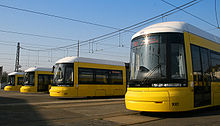| Berlin tramway | ||||||||||||||||||||||||||||
|---|---|---|---|---|---|---|---|---|---|---|---|---|---|---|---|---|---|---|---|---|---|---|---|---|---|---|---|---|
 | ||||||||||||||||||||||||||||
| Operation | ||||||||||||||||||||||||||||
| Locale | Berlin, Germany | |||||||||||||||||||||||||||
| ||||||||||||||||||||||||||||
| ||||||||||||||||||||||||||||
The Berlin tramway (German: Straßenbahn Berlin) is the main tram system in Berlin, Germany. It is one of the oldest tram networks in the world having its origins in 1865[6] and is operated by Berliner Verkehrsbetriebe (BVG), which was founded in 1929.[6] It is notable for being the third-largest tram system in the world, after Melbourne and St. Petersburg.[7] Berlin's tram system is made up of 22 lines[1] that operate across a standard gauge network, with almost 800 stops and measuring almost 190 kilometres (120 mi) in route length and 430 kilometres (270 mi) in line length.[4] Nine of the lines, called Metrotram, operate 24 hours a day and are identified with the letter "M" before their number;[2] the other thirteen lines are regular city tram lines and are identified by just a line number.[3]
Most of the current network is within the confines of the former East Berlin, as tram lines within West Berlin were replaced by buses during the division of Berlin. However, the first extension into West Berlin opened in 1994 on today's M13. In the eastern vicinity of the city there are also three private tram lines that are not part of the main system; the Potsdam tram system, with its own network of lines, is just to the south-west of Berlin.
- ^ a b "The company in brief Berliner Verkehrsbetriebe". BVG. Retrieved 5 March 2015.
- ^ a b "Travel information – Overview of our lines (Metrotram)". BVG. Retrieved 5 March 2015.
- ^ a b "Travel information – Overview of our lines (Tram)". BVG. Retrieved 5 March 2015.
- ^ a b "Lines & Networks – Means of transport and lines – Tram – Trams". BVG. Archived from the original on 27 July 2014. Retrieved 30 April 2014.
- ^ "Zahlenspiegel 2018" [Statistics 2018] (PDF) (in German). Berliner Verkehrsbetriebe (BVG). 31 December 2018. p. 2. Retrieved 26 June 2019.
- ^ a b "Berliner Straßenbahn mit langer Tradition" [Berlin Trams' Long Tradition] (in German). BVG. Retrieved 5 March 2015.
- ^ "Wien hat das fünftgrößte Straßenbahnnetz der Welt" [Vienna has the fifth largest tramway network in the world]. wienerlinien.at (in German). Wiener Linien. 2011. Archived from the original on 31 October 2013. Retrieved 31 August 2013.
